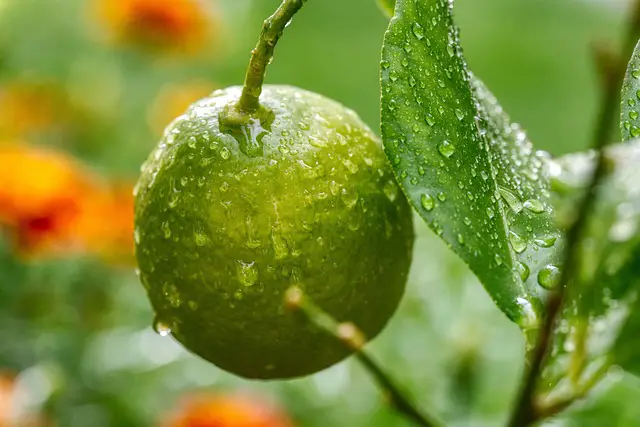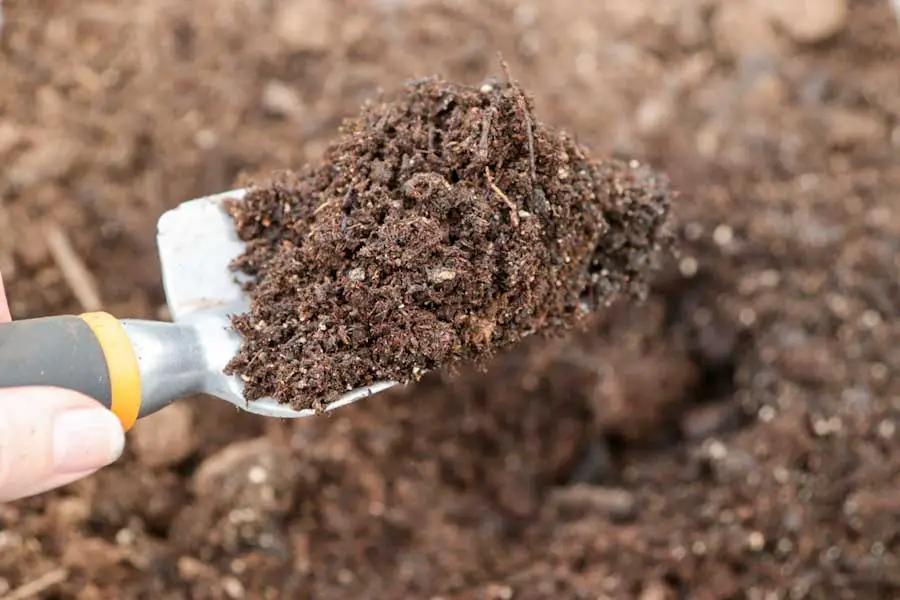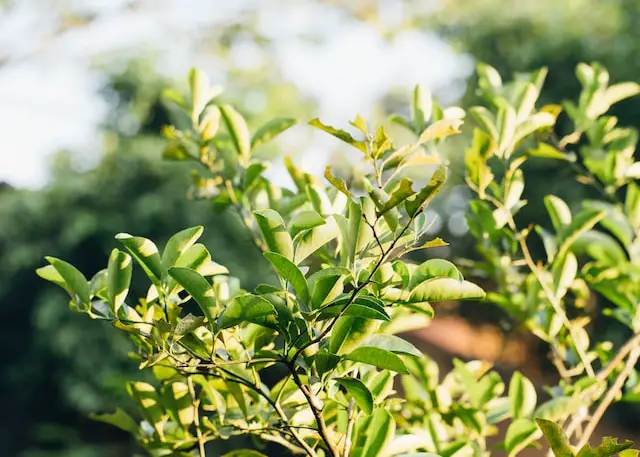
I have several potted citrus trees – Improved Meyer and Pink Variegated lemons, Moro blood orange, and Key lime, plus more to come. One of the biggest learning curves of planting citrus trees, whether in the ground or in a container, is giving them the right amount of water.
When a citrus tree (or person, for that matter) shows signs of stress, the only way to fix it is to discover the source of the stress. But when it comes to watering, how do you tell the difference between too much or too little? And what can you do to correct an overwatered or underwatered citrus tree?
Overwatered citrus trees will have yellow, drooping leaves which could lead to defoliation, weakening of the tree, and root rot. Underwatered citrus trees will have leaves that curl in at the edges and look wilted, and the soil will appear dry and shrunken.
To help the tree recover, take stock of the growing situation, location, soil drainage, and your own watering habits. In many cases, a few minor adjustments will make all the difference in the health of your citrus trees.
Signs Your Citrus Tree is Overwatered
Citrus trees will give you some obvious clues that they’re getting waterlogged. The key is knowing what to look for and how to diagnose the cause of the issue. Here are some of the symptoms of an overwatered citrus tree:
1. Leaves that are yellowed, slightly cupped or folded, drooping, and/or with brown edges.
The first signs of overwatering will show on the leaves. They will become lighter in color or uniformly yellow. There are other reasons for yellowing leaves, such as nutrient deficiencies, so check for other symptoms before correcting the problem.

The leaves may also have a slightly folded shape. (This is different than a tree that is underwatered, where you might see the leaves roll up like a cigar.) The leaves will droop, and you may notice some browning along the outside edges.
2. Premature dropping of leaves, blossoms, or fruit.
It’s common for leaves to drop off a tree after they’ve reached maturity, typically after 2 years. But leaves that drop after turning yellow or brown may indicate an overwatering problem.
Blossoms and fruit will also fall off prematurely if the watering issue continues. Any time a citrus tree is under prolonged stress, such as when its roots can’t get enough oxygen due to waterlogged soil, it will conserve energy by dropping fruit, leaves, or blossoms.
3. Split fruit.
This will happen if the tree becomes overwatered in the late fall once the fruit has reached its mature size. The rind will no longer grow, but excess watering could cause the fruit to expand from the inside, splitting the rind. Splitting can invite pest issues or rot, making the fruit inedible.
4. Puddles sitting around the tree after irrigation.
For citrus trees planted in the ground, a sign of overwatering is visible puddles long after rain or other irrigation. If you notice standing water a few hours after a rain storm, there may be an issue with drainage. Poorly drained soil can cause the tree’s roots to rot or become waterlogged.

5. Stunted growth or weak branches.
If the tree looks weak, stunted, or lackluster overall, look closer for signs of overwatering. Too much water will stress the tree, weakening it and leaving it susceptible to other problems.
6. Root rot.
All of the above symptoms could be signs that the tree is suffering from root rot (also called foot rot). You may also notice decay or lesions at the base of the trunk. There may be visible white mold or fungus growing on the soil surface.
Root rot is caused by the lack of airflow around the roots. It can happen very quickly if a plant is sitting in waterlogged soil for too long. Root rot is a common cause of death for many citrus trees.
How to Fix an Overwatered Citrus Tree
Once you’ve confirmed that your tree is showing symptoms of being overwatered, the next step is to figure out the reason why. If you catch the signs soon enough, the problem can be fixed.

Problem: Drainage
Citrus trees love humid air, but they prefer well-draining soil that doesn’t hold onto too much moisture. In the ground, drainage issues could be caused by soil that has too much clay. A sandy loam is ideal for citrus trees.
For potted citrus, use a lightweight soilless potting mix that’s formulated for citrus trees. One I like is this Gardinera Citrus Tree Potting Soil Mix. It’s on the pricy side, but it has a good mix of ingredients for citrus trees, including coconut coir, perlite, and worm castings.
An even better alternative, in my opinion, is to make your own potting mix. I wrote an article all about how to make a mix that is perfect for citrus trees: The Best DIY Citrus Potting Mix Recipe (Plus 5 Brands to Try) This is what I use in my pots, and I find it to be very forgiving of watering inconsistencies (which I am certainly guilty of from time to time).

Whatever potting mix you choose, make sure it has some larger pieces (such as pine bark or other material) to keep the soil from becoming compacted. The idea is to have both good drainage and airflow – both water and air should be able to circulate easily.
The pot should have moderate-sized drainage holes in the bottom. Holes that are too small could get clogged easily, and holes that are too large may allow the potting soil to fall out.
Solution:
If your pot is missing drainage holes, remove the tree from the pot and drill a few holes in the base of the pot (or choose a different container). If your pot already has drainage holes, use a screwdriver or other tool to poke the drainage holes and clear away any soil that may be clogging them.
It’s good practice to refresh the potting soil in your potted plants about every three years by repotting the tree. Soil gets compacted over time, and as roots grow, fresh soil is needed to invigorate the plant.

If you suspect your soil is too water-retentive, adjust the soil by adding aerating and drainage-enhancing ingredients. Perlite, vermiculite, or sifted pine bark mulch will lighten the soil and improve drainage issues in pots. For inground trees, dig in some fresh compost around the tree, particularly near the dripline.
Use a skewer or wire to poke a few deep holes around a potted tree. This will improve airflow around the deeper roots and help the soil dry out more quickly. Do the same for in-ground trees – use a broom handle or large stake to pierce the soil and allow air to reach deep down and help dry out the ground.
Problem: Watering Frequency
Citrus trees need to be watered at different frequencies depending on temperature, the size and age of the tree, the season, and whether the tree is potted or planted in the ground.
When the soil around the roots gets waterlogged, air can’t move around the roots. This actually inhibits the roots from being able to absorb nutrients. It also keeps the plant from having the energy it needs to grow, blossom, and fruit.
Learn more: Watering Lemon Trees: How to Get It Just Right
For both potted and inground trees, wait until the top 2 to 3 inches of the soil is completely dry before watering. The easiest way to do this is to simply stick your finger in the soil. If it’s dry to the second knuckle, then go ahead and water it.

Another problem with overwatering potted trees in particular, is that nutrients leach out of the soil. Fertilizing is a crucial part of potted citrus tree care. But a plant that is already stressed by overwatering won’t be able to absorb the nutrients you give it.
Related: Fertilizing Potted Lemon Trees: Everything you NEED to Know
Solution:
Do not water your citrus tree if the soil is visibly moist on top. Be sure to check a few inches into the soil to see how wet it is. You can also use a wooden skewer to see how damp the soil is below the surface.
If your plant looks droopy but perks up about a day after watering, then you probably need to water a little more often. But if your plant looks droopy, has yellow leaves, and doesn’t perk up after watering, chances are you’re watering too frequently.
It’s better to water your citrus trees less frequently but deeply, letting the soil partially dry out between waterings. Frequent shallow irrigation won’t allow salts and chemical buildup to flush out of potted tree containers. In the ground, shallow watering will encourage roots to grow close to the surface which could cause them to dry out too quickly.
Problem: Environment
As water is absorbed by the roots, air circulation allows excess moisture to evaporate from the leaves. This evaporation is improved in warmer temperatures and with more sunlight. Lower temperatures and lower light reduce the amount of evaporation that happens, which can lead to a waterlogged plant.
Solution:
Citrus trees need light and air in order to dry out after overwatering. If you’re growing your citrus tree indoors and suspect it may be overwatered, bring the tree outside on a mild or warm day. The warmer temperature and open air will help dry the plant out more quickly.

For an in-ground tree, prune away branches of other plants that are crowding the citrus tree. You may also need to lightly prune the citrus tree to increase airflow. However, if the tree is extremely stressed due to overwatering, minimize any pruning until it recovers.
Be sure to place potted trees in a location that gets plenty of sunlight, warmth, and airflow. If the tree lives indoors most of the year, bring it outside in the summer to give it a chance to live in a more optimal environment.
Problem: Pot Size
Larger pots tend to retain more moisture than smaller pots. Always correspond the pot size to the size of the tree or plant. A tree that is “drowning“ in soil may have trouble drying out between waterings. Even if you have to pot up in size every couple of years as the tree grows, it’s better than planting a small tree in an oversized pot.
Solution:
Plan to increase the pot size every couple of years as the tree grows. The new pot should be only a little bigger than the current size pot. As a good rule of thumb, plant the tree in a pot that leaves 1-2 inches of space around the current root ball. Once the tree approaches its mature size, repot it every few years to give it new potting soil.

Repotting will also help you keep an eye on the drainage and quality of the soil in the pot. Refreshing the potting soil will also replenish nutrients and reinvigorate the tree.
Problem: Season
Citrus trees have different watering needs depending on the season. As the tree grows, flowers, and fruits, it needs to absorb more water to support these processes.
But as cooler temperatures come, most citrus trees enter a state of semi-dormancy. Their growth slows down significantly in the winter, so they need far less water. In warm climates, some citrus trees may continue to send out new growth year-round. In this case, continue your regular watering regimen throughout the year.
Also, learn the habits of your tree. For example, lemon trees will generally need more water than orange trees. Potted trees may need to be watered more frequently, especially if they live outdoors. Indoor potted trees will need less water because they’re in an environment without wide temperature swings.

In-ground trees need frequent, consistent watering for the first few months after they’re planted. They continue to need regular watering during the first year or two, particularly during periods of drought. Once the tree is mature, it will need a little extra irrigation. In-ground roots become quite adept at searching out water deep in the soil.
Solution:
Slow down your watering schedule to correspond with the tree’s slower growth in winter. Increase the watering schedule in periods of drought or extreme heat.

Problem: Root Rot
If your citrus tree stays in waterlogged soil for too long, it can lead to root rot. Signs of root rot include yellowing leaves, loss of foliage, an unpleasant smell, or visible white growth on soil or around roots.
Root rot in citrus is typically caused by the Phytophthora or Armillaria fungi. These fungal spores live in the soil and are encouraged to grow in soggy environments, such as waterlogged soil.
Solution:
Luckily, root rot in potted citrus trees can be remedied if you catch it early. To check if your tree has root rot, gently dig around in the soil to see how saturated it is. Always wear gloves and sanitize any tools to prevent the infection from spreading.
If the tree is small, take it to a sink and use gravity to “shake” excess water from the pot. Take the tree outside in the sun and give it a chance to dry out.
If the soil is extremely wet, it may be necessary to replace the potting mix. Remove the tree from its pot and shake off as much wet soil as you can. Trim any damaged roots with sanitized pruning shears. Wash the pot thoroughly to remove any residue from the old soil. Re-pot the tree with fresh, well-draining potting mix.
For in-ground trees, the best treatment is prevention. Pay attention to cultural practices such as drainage and irrigation. Avoid getting the trunk wet or over-irrigating.
Signs Your Citrus Tree is Underwatered
It can be a little confusing to know whether a stressed-looking citrus tree is being underwwatered or overwatered. Once again, though, the tree will give you some signs to help you determine what the problem is.

1. Leaves that look dry, dull, or are curled in at the edges.
The leaves of an underwatered citrus tree will have a dull appearance, in contrast to the sheen that healthy leaves have. New leaves may curl in lengthwise at the edges, like a cigar.
2. Wilting of new growth.
The young, tender leaves and stems of a citrus tree will be the first to show signs of drought stress. You may notice wilting or drooping of the light green new growth.
3. Browning or premature dropping of the leaves.
If the lack of water continues, the curled-in leaves will eventually turn brown and fall off the tree. A thirsty citrus tree will struggle to support its entire leafy canopy, so it must get rid of foliage. This doesn’t necessarily mean the tree is beyond recovery yet, but it puts even more stress on the tree.
FRUIT GROVE TIP: Drought-stressed citrus leaves may look rolled or curled in at the edges, and often have a dull appearance. Overwatered leaves are pale or yellowed, brown around the edges, and may be somewhat cupped-looking. Both conditions can cause leaves to drop prematurely.
4. Soil that looks dry, dusty, and shrunken in the pot.
Container-grown citrus trees will show their dryness in the soil. It will appear dry, hard, and dusty on the surface. Since all of the moisture has evaporated, the soil will shrink and leave a gap of space next to the walls of the pot.
5. Small fruit.
A drought-stressed citrus tree will struggle to develop fruit without enough water. The fruit will be smaller in size because the plant doesn’t have enough energy to support its growth. The citrus fruit itself may also be drier and have less flavor.
How to Fix an Underwatered Citrus Tree
If the soil has completely dried out, water the tree slowly so the moisture can seep into the soil. If you water too quickly, it will just drain down the sides of the soil in the gap next to the pot. The roots won’t have a chance to absorb the water. Use a hose or watering can and let the water trickle slowly into the soil.

Or, perhaps even better, water the tree from below. Place the pot in a large plant saucer or other container. Fill the container with several inches of water and let the plant soak it in. Check the container after 10 minutes and add more water if needed. Once the soil is consistently moist, or after about 30 minutes, dump out any remaining water and return the tree to its spot.
Adjust your watering schedule so the tree doesn’t become drought stressed again. Consider installing drip irrigation or a soaker hose around the tree. Potted citrus trees may need to be watered daily (or more!) in summer. In my hot climate, I often have to water my citrus trees twice a day. I also move them so they receive some afternoon shade during the worst heat of summer.
Observe your citrus trees regularly. If you learn to recognize the signs of too much or too little water, then it’s simple to intervene and make corrections. Your trees will thank you.

